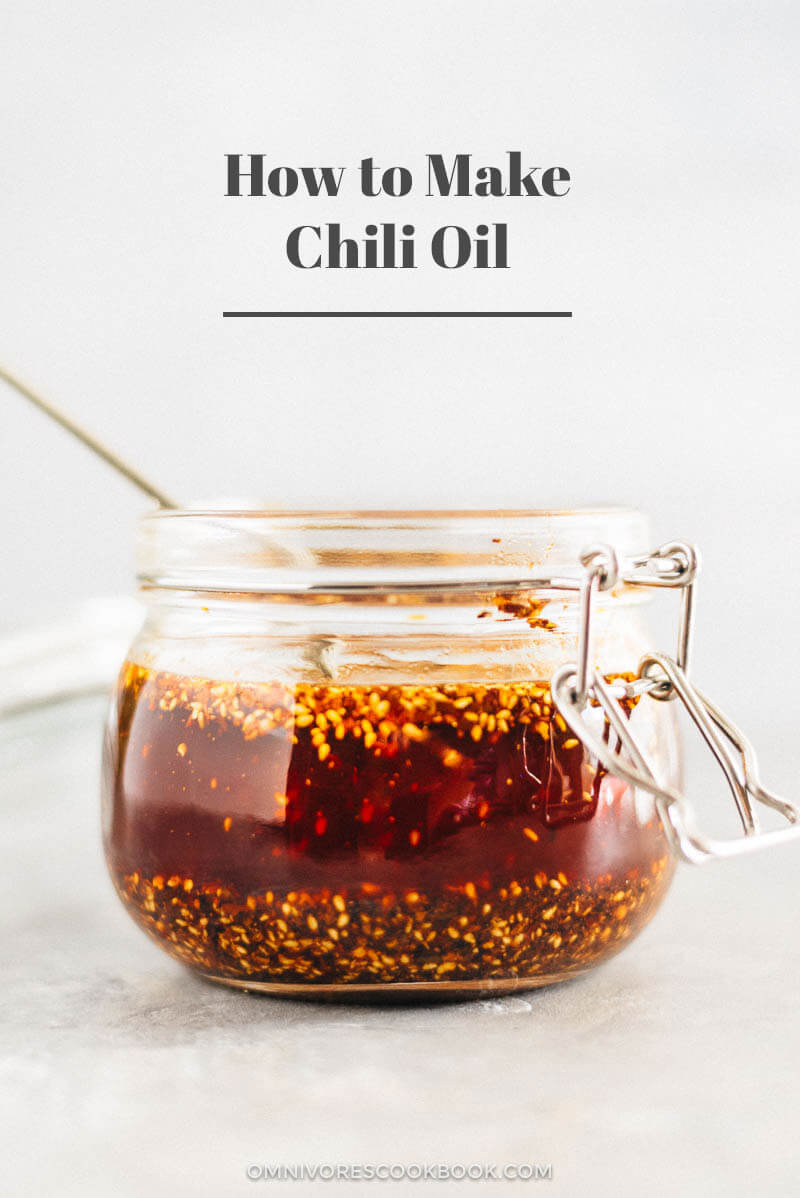
Chili oil is such an important staple for Chinese families, equal to soy sauce and vinegar. For many Chinese people chili oil is as important as ketchup is to American people. It always shows up on tables of small diners, no matter whether it’s a dumplings or noodle place. Once you’re hooked, you’ll want to pour it on everything.
Whenever I’m talking about chili oil, I always refer to homemade chili oil. It tastes ten times better than the store bought product, lasts just as long if you store it in the fridge, and does not contain additives or MSG. There is this fresh aromatic nuttiness that bottled chili oil never delivers.
Plus, when you use chili oil like a Chinese person, you gotta mix in the chili flakes as well. The chili flakes are well toasted when you cook the chili oil, so they taste less spicy but quite smoky with a crispy texture. When mixing with noodles, these tiny umami bits coat the ingredients evenly and each bite releases waves of piquant zing to your taste buds. It’s as exciting as throwing a handful of Pop Rocks in your mouth!
When I cook Vegetable Chow Mein, Lanzhou Beef Noodle soup, and hearty Sesame Noodle Salad, I’ll always spoon a few dollops of chili oil mixed with thick chili flakes onto my finished dish. This one small action will elevate your cooking from mundane to heavenly.
Cooking process
The process might look intimidating at first, but you won’t believe how easy it is once you try it. There are three steps involved.
(1) Combine chili flakes with aromatics of your choice in a heatproof bowl.
A ceramic bowl is my go-to choice. If you plan to use a glass jar, make sure it is heatproof. We will be dealing with hot oil in the next step. Using glassware might cause the glass to shatter and can be very dangerous.
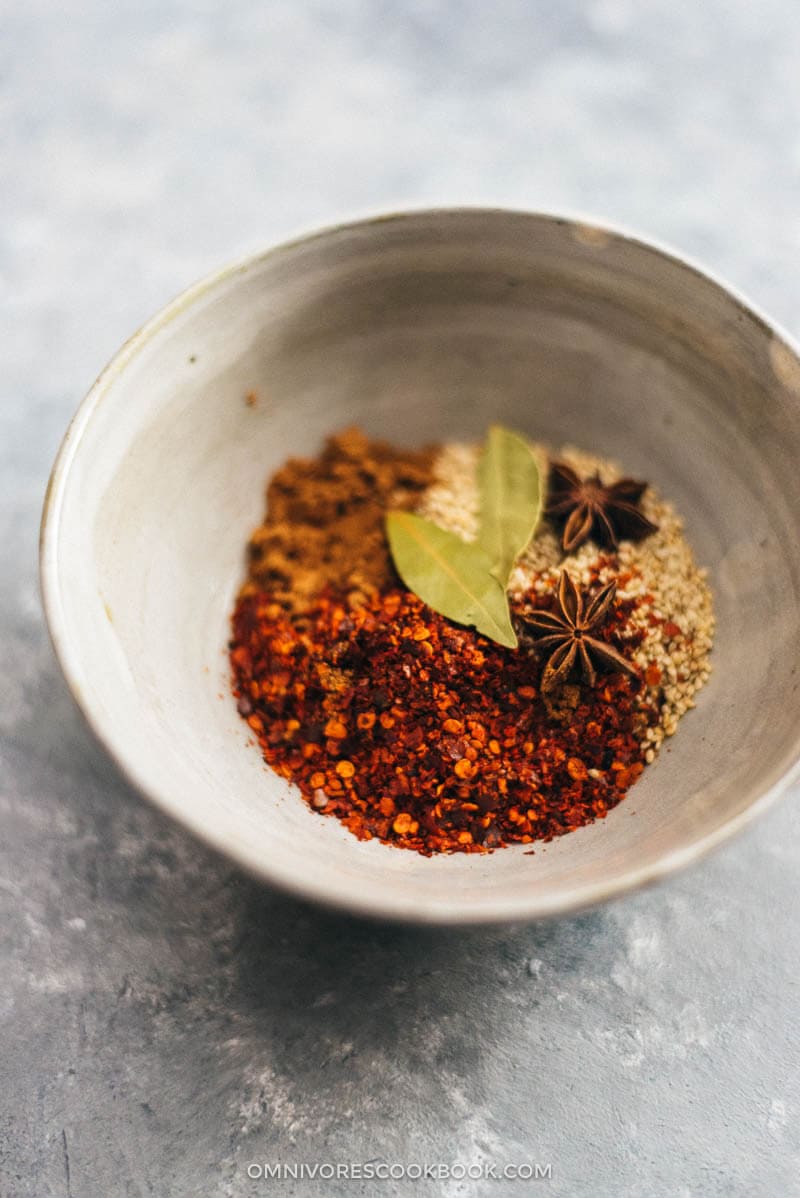
(2) Heat the oil until it reaches 370 degrees F (190 C).
The key to making delicious chili oil is to heat the oil hot enough without overheating it. The hot oil will cook the spices thoroughly and be infused with various flavors. However, if the oil is too hot, it will burn the pepper flakes and sesame seeds, and the resulting chili oil will be bitter in taste.
The best way is to use an instant thermometer to monitor the oil. If you do not have a thermometer, I also introduce a “ginger method” in the recipe below, which is a good indicator of the oil temperature.
Select a small saucepan that has long handle and is good for pouring. Alternatively, you can also use a ladle to transfer the oil.
(3) Pour oil into the bowl with chili flakes.
The oil will bubble fiercely at first and quickly cook the chili flakes. Simply mix everything together with a spoon and let the oil sit until cooled down.
That’s it! Now you have a jar of delicious chili oil to use to create an authentic Chinese flavor.
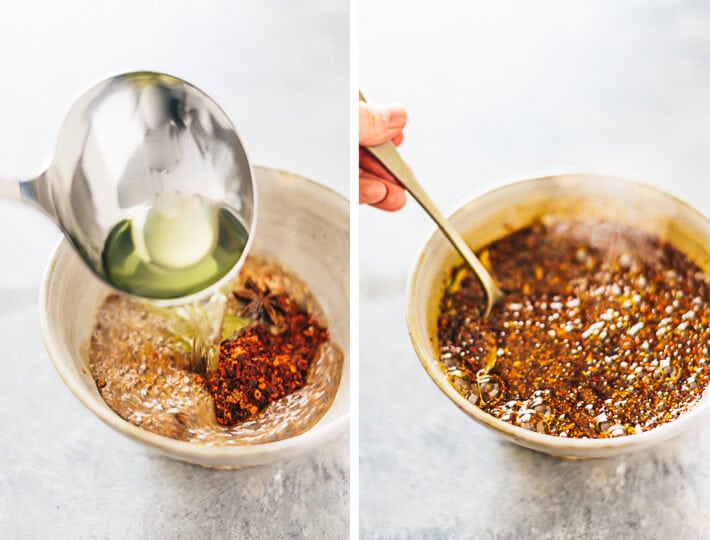
More cooking notes
(1) What types of chili flakes should you use?
The best option is to use fresh chili flakes imported from Sichuan. This type of chili flake is made with premium chili peppers of a vibrant red color. The blend also contains fewer seeds, so your chili oil won’t end up overly spicy.
The next best option is using Korean chili flakes. With these, I found my chili oil doesn’t have the brightest red color, but it doesn’t affect the taste.
(2) How do you make chili flakes?
You can use whole dried chili peppers to make chili flakes too. Lightly toast the peppers in a pan until the pepper turns a bit darker, and grind the peppers into chili flakes. To make sure the oil won’t turn out too spicy, cut open half of the hot peppers with kitchen shears and discard the seeds.
(3) What types of aromatics should you use in the chili oil?
The answer is, you can use many types of aromatics or none at all. The flavor is totally up to personal preference. In China, each region down to each family has their own formula to make their favorite chili oil.
To make the most basic chili oil, you can simply use chili flakes. Some versions use ginger, cinnamon bark, bay leaves, star anise etc.
The recipe below is our family’s formula. We always enjoy adding a few Sichuan peppercorns to add a hint of numbing nuttiness. We also use a pinch of five spice powder to add umami.
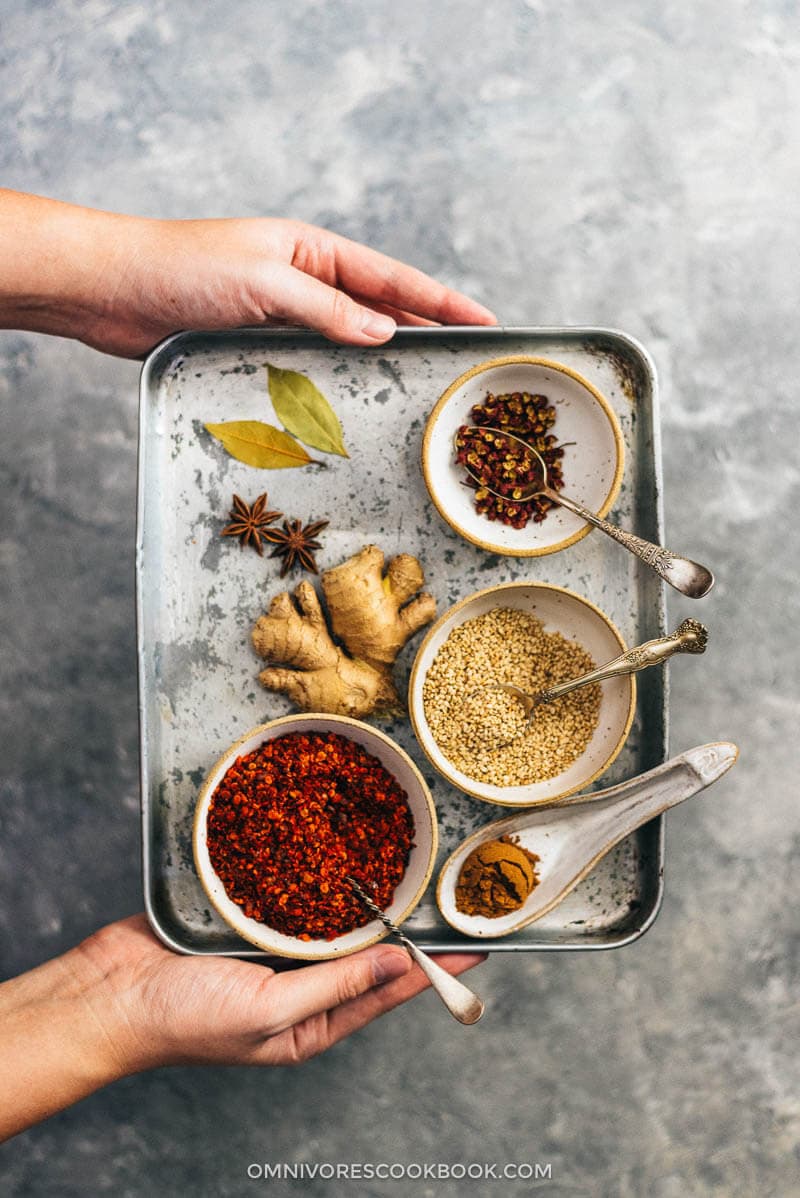
(4) To filter or not to filter the chili flakes?
Once you’ve made the chili oil, you can either filter the oil and discard the chili flakes, or you can leave them in. This habit varies a lot in China depending on the region, so I’d say both methods are authentic and correct.
As a northerner, I grew up having chili oil with tons of chili flakes sitting at the bottom. In fact, in many restaurants you will find the chili oil jar is filled mostly chili flakes and very little oil.
Again, if you choose proper chili flakes (see point #1 above), your chili oil will not be very spicy and it should taste nutty with a balanced umami flavor. The chili flakes should add texture and smokiness to your dish, not spiciness.
How to use chili oil
- Make authentic Sichuan food: Mapo Tofu, Sichuan Spicy Wonton in Red Oil, Sichuan Sliced Beef in Chili Sauce (Fu Qi Fei Pian), Bang Bang Chicken
- Drizzle on soup to make them taste better immediately: Wonton Soup, Instant Pot Chicken Noodle Soup, 15-Minute Curry Ramen with Leftover Ham
- Make a simple cold dish taste irresistible: Real Deal Sesame Noodles, Cucumber Salad
- Use it on congee and oatmeal: 5-Ingredient Savory Oatmeal (Chinese-Style)
- Use it on your roast veggies to add tons of flavor (extremely helpful if you follow a vegetarian or vegan diet)
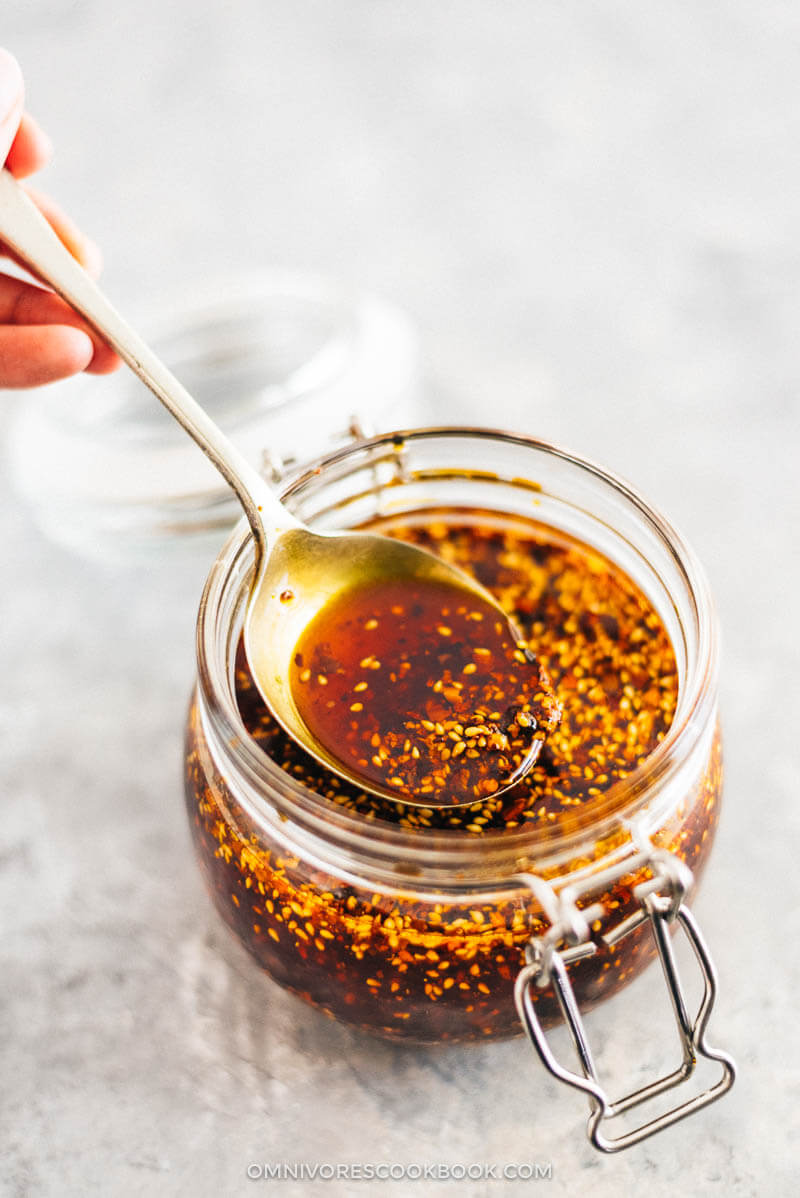
Other homemade Chinese sauces & condiment
- Chinese BBQ Sauce
- Chinese Flavored Sweet Soy Sauce
- Vegetarian Oyster Sauce
- Homemade Black Bean Sauce
If you give this recipe a try, let us know! Leave a comment, rate it (once you’ve tried it), take a picture and tag it @omnivorescookbook on Instagram! I’d love to see what you come up with.
Chinese Cooking Made Easy
Are you new to this website? This free email series is a great place to start. I’ll walk you through a few of my most popular recipes and show you how and why they work. You’ll quickly start to cook better Chinese food in your own kitchen.
Watch video
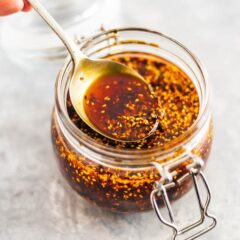
How to Make Chili Oil (辣椒油)
Ingredients
- 4 tablespoons Chinese chili flakes (*footnote 1)
- 2 teaspoons five spice powder
- 3 tablespoons toasted sesame seeds
- 1 teaspoon ground Sichuan peppercorn
- 1 whole star anise (Optional)
- 2 bay leaves
- 1 cup vegetable oil (or grapeseed oil)
- 1 piece thinly sliced ginger (Optional)
Instructions
- Combine chili flakes, five spice powder, sesame seeds, star anise, Sichuan peppercorns, and bay leaves in a heatproof ceramic bowl that can hold at least 2 cups liquid. Place the bowl on a heat resistant coaster.
- Heat oil in a wok (or a skillet) over medium-high heat. Add ginger. When the ginger starts to wither and turns golden brown, immediately turn off the heat. The oil should reach 370 degrees F (190 C) and no higher than 400 F (200 C) if read with an instant thermometer.
- Carefully pour oil or use a ladle to transfer oil into the bowl of mixed spices. The oil will bubble for a few seconds and cook the spices. While the the oil is bubbling, use a metal spoon to stir gently to mix the spices, so they’ll cook thoroughly.
- When the oil cools down a bit, scoop out and discard the star anise and bay leaf.
- The oil is now ready to use! Its flavor will mature if you let it rest for a day, allowing the spices to infuse into the oil.
- The oil can be stored covered at room temperature for two weeks, or up to six months in the fridge in an airtight container.
Notes
Nutrition

Did you make this recipe?
I’d love to hear how it turned out for you! Please take a moment to leave a 5-star rating ⭐️ and share your thoughts in the comments further down the page. It really helps others discover the recipe too.
The recipe was originally published on August 7, 2014, and updated on April 23, 2017.

Mobarak Almas
Thank You MAGGIE zhu Stay Blessed*
Nick
I’ve just started the adventure of cooking Chinese/Szechuan and bought (at a friend’s suggestion) rice bran oil. Is this the oil I should use for your recipes, and for chili oil in particular?
Thanks very much!
Nick
ps. At your suggestion I bought five key ingredients from Mala Market – they arrived today.
Maggie Zhu
Rice brain oil is a high smoking point neutral oil, which is great for making chili oil and stir fried dishes. I hope you enjoy cooking with the new ingredients!